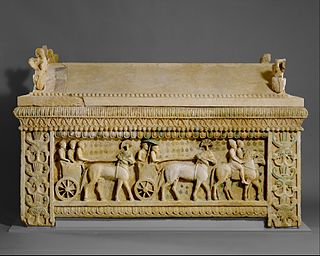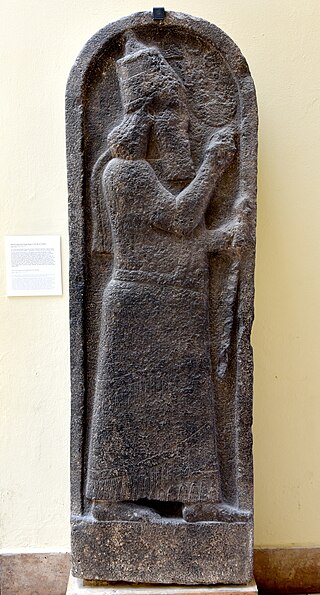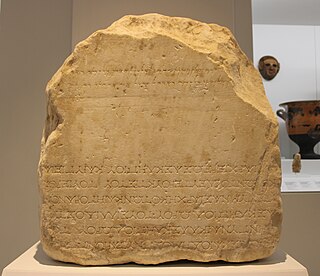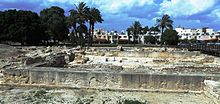
Amathus or Amathous was an ancient city and one of the ancient royal cities of Cyprus until about 300 BC. Some of its remains can be seen today on the southern coast in front of Agios Tychonas, about 24 miles (39 km) west of Larnaca and 6 miles (9.7 km) east of Limassol. Its ancient cult sanctuary of Aphrodite was the second most important in Cyprus, her homeland, after Paphos.

Human habitation of Cyprus dates back to the Paleolithic era. Cyprus's geographic position has caused Cyprus to be influenced by differing Eastern Mediterranean civilisations over the millennia.

Salamis was an ancient Greek city-state on the east coast of Cyprus, at the mouth of the river Pedieos, 6 km north of modern Famagusta. According to tradition, the founder of Salamis was Teucer, son of Telamon, king of the Greek island of Salamis, who could not return home after the Trojan War because he had failed to avenge his brother Ajax.

Soli or Soloi is an ancient Greek city on the island of Cyprus, located next to the town of Karavostasi, southwest of Morphou (Guzelyurt), and on the coast in the gulf of Morphou. Since 1974 the site has been within the territory of the Turkish Republic of Northern Cyprus.

Larnaca is a city on the south east coast of Cyprus and the capital of the district of the same name. It is the third-largest city in the country, after Nicosia and Limassol, with a metro population of 144,200 in 2015.

The ancient history of Cyprus shows a precocious sophistication in the Neolithic era visible in settlements such as at Choirokoitia dating from the 9th millennium BC, and at Kalavassos from about 7500 BC.

Idalion or Idalium was an ancient city in Cyprus, in modern Dali, Nicosia District. The city was founded on the copper trade in the 3rd millennium BC. Its name does not appear, however, on the renowned "Kition Stele", i.e., the Sargon Stele of 707 BC, but a little later on the Prism of Esarhaddon known as Niniveh A wherein the name is prefixed by the modifier URU (city) as URU.e-di-ʾi-il and in similar spellings in Ashurbanipal's annal while modified by KUR (land/kingdom).

Kourion was an important ancient Greek city-state on the southwestern coast of Cyprus. In the twelfth century BCE, after the collapse of the Mycenaean palaces, Greek settlers from Argos arrived on this site.
The Cypro-Minoan syllabary (CM), more commonly called the Cypro-Minoan Script, is an undeciphered syllabary used on the island of Cyprus and at its trading partners during the late Bronze Age and early Iron Age. The term "Cypro-Minoan" was coined by Arthur Evans in 1909 based on its visual similarity to Linear A on Minoan Crete, from which CM is thought to be derived. Approximately 250 objects—such as clay balls, cylinders, and tablets which bear Cypro-Minoan inscriptions, have been found. Discoveries have been made at various sites around Cyprus, as well as in the ancient city of Ugarit on the Syrian coast. It is thought to be somehow related to the later Cypriot syllabary.

The Swedish Cyprus Expedition was assembled to systematically investigate Cyprus’s early archaeological history. The expedition occurred between September 1927 and March 1931 and was led by the three archaeologists Einar Gjerstad, Erik Sjöqvist and Alfred Westholm together with the architect John Lindros who photographed during their time in Cyprus. The excavation constitutes the foundation of modern archaeology in Cyprus. The results of the excavations revealed that the distinctive culture of early Cyprus had been created in close contact with various cultures from the Middle East and the western Mediterranean areas.
Agia Eirini or Agia Irini is a village located on Morphou Bay, approximately 10 km north of Morphou. The village is located within Kyrenia District. It is under the de facto control of Northern Cyprus.

Roman Cyprus was a small senatorial province within the Roman Empire. While it was a small province, it possessed several well known religious sanctuaries and figured prominently in Eastern Mediterranean trade, particularly the production and trade of Cypriot copper. The island of Cyprus was situated at a strategically important position along Eastern Mediterranean trade routes, and had been controlled by various imperial powers throughout the first millennium BC. including: the Assyrians, Egyptians, Persians, Macedonians, and eventually the Romans. Cyprus was annexed by the Romans in 58 BC, but turbulence and civil war in Roman politics did not establish firm rule in Cyprus until 31 BC when Roman political struggles ended by Battle of Actium, and after about a decade, Cyprus was assigned a status of senatorial province in 22 BC. From then until the 7th century AD, Cyprus was controlled by the Romans. Cyprus officially became part of the Eastern Roman Empire in 293 AD.

Larnaca District Museum is a museum in Larnaca, Cyprus that has displays that show the "historical development of the city of Kition and the District of Larnaka in general." It was inaugurated in 1969. and was formerly named Larnaca District Archaeological Museum. It is controlled by the Department of Antiquities.

The Sargon Stele was found in the autumn of 1845 in Cyprus on the site of the former city-kingdom of Kition, in present-day Larnaca to the west of the old harbour of Kition on the archaeological site of Bamboula. The language on the stele is Assyrian Akkadian.
The Mnemata Site is an archaeological excavation site at the Mnemata locality of Larnaca, Cyprus. A tomb was discovered in 1979—during the construction of a refugee settlement.
The pottery of ancient Cyprus starts during the Neolithic period. Throughout the ages, Cypriot ceramics demonstrate many connections with cultures from around the Mediterranean. During the Early and Middle Bronze Ages, it is especially imaginative in shape and decoration. There are also many early terracotta figurines that were produced depicting female figures.

The Kition Necropolis Phoenician inscriptions are four Phoenician inscriptions discovered in the necropolis of Tourapi at Kition in 1894 by British archaeologist John Myres on behalf of the Cyprus Exploration Fund.
Mersinaki is an ancient place located near the shore, between Vouni and Soli, in Cyprus. The Swedish Cyprus Expedition, led by Einar Gjerstad, excavated Mersinaki during the year 1930 and found an open-air sanctuary by a river delta.

Pumayyaton and Pnytarion's inscriptions are two separated inscriptions, Phoenician and Greek, engraved on the same marble base which was found in Gdhi or Gai locality near Dromolaxia. About 3 hundred years after the first inscription, the Phoenician, was engraved, the base was turned upside down and the second inscription, in Greek, was engraved; the inscriptions have no connection and are not a bilingual inscription. Eventualy, it was used as a press. It is now exhibited in Larnaca District Archaeological Museum.
Marguerite Yon, or Marguerite Yon-Calvet, is a French archaeologist and Assyriologist specializing in the ancient Near East, particularly Ugarit in Syria. She is widely recognized for her archaeological work on Ugarit, where she conducted excavations for twenty years. Additionally, she has extensively excavated the island of Cyprus. Notably, she held the distinction of being the first female president of the Academy of Lyon since 1701.






















